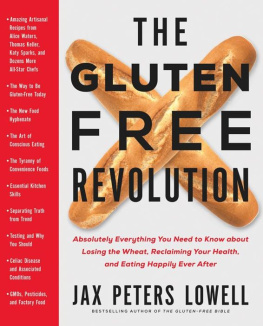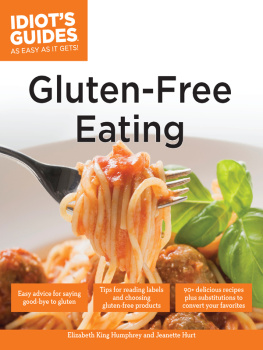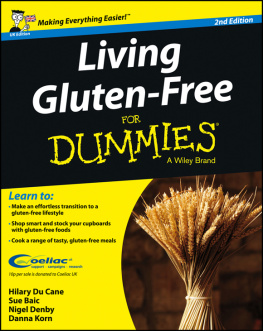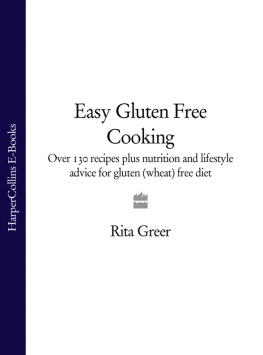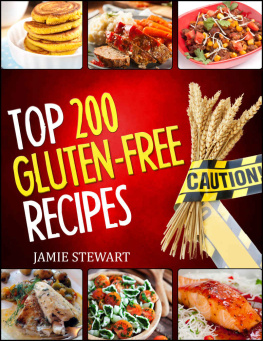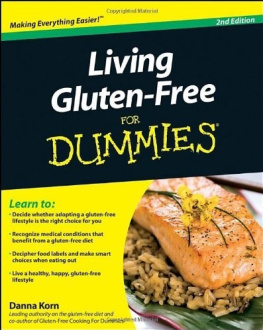
The author and publisher have provided this e-book to you for your personal use only. You may not make this e-book publicly available in any way. Copyright infringement is against the law. If you believe the copy of this e-book you are reading infringes on the authors copyright, please notify the publisher at: us.macmillanusa.com/piracy.
Please note that some of the links referenced in this work are no longer active.
In memory of the angels at my table:
Kay and Jack Peters, Catherine Petitpain
For John, always
Contents
by A NTHONY J. D I M ARINO J R., MD
Gluten-Free Poem
There is no wheat in this poem,
no barley, rye or derivatives thereof.
I cant say why, but it doesnt involve
any sort of nut. Cross contamination
is not an issue here. These words are
100% safe to eat.
There is longing, though. And heat.
A phantom crumb lingers on the tongue,
buttered with hungry eyes. Jam sticky lust
licks its finger and thumb, some sugar
to swallow down with the losses.
One in 132 poets experience the urge
to fondle dinner rolls, swoon
at the sight of a batter-coated spoon,
slow walk past the patisserie,
breathe from the knees
sweet burnt air to last a lifetime.
While these lines contain absolutely no lactose,
high fructose corn syrup, casein, palm kernel oil
or genetically modified ingredients,
they do possess a prayer,
a memory, a wish, the taste
of every forbidden dish.
J AX P ETERS L OWELL
When I first met Jax Peters Lowell in September 1996, it was clear I was in the presence of one of the most highly motivated patients Id met in my many years of practice. Here was someone possessed of enormous energy with great respect for knowledge. She was willing and able to do her homework, assessing treatment options so that her decisions were always well informed. It was apparent to me from the start that we would be more like colleagues in our joint effort to understand and overcome the medical obstacles and complications presented by long-standing celiac disease.
But thats only half the story. The other side of this highly motivated, smart, and courageous woman is that of a skilled communicator, first-rate writer, and gifted speaker. I have asked Jax to apply her quietly persuasive humor to more than one recalcitrant gluten-intolerant patient and she has done so with tact, charm, and her trademark resourcefulness. Add to this her great generosity and a powerful desire to use her talent to help others, and its no surprise that her first book, Against the Grain , and its second edition, The Gluten-Free Bible , became bestsellers.
When she asked me to write the foreword for The Gluten-Free Revolution , her definitive work on the gluten-free lifestyle, I felt like the village painter summoned by Michelangelo to paint his house. Shes that good. Not only has she produced another important resource for those with celiac disease and varying degrees of gluten intolerance and sensitivity; she has chronicled the choices and challenges we all face in the post-gluten age.
The detail, specificity, and scope of The Gluten-Free Revolution is on a par with what a medical specialist would provide, but in her hands, complicated issues are accessible and easy to understand. As complete and instructive as the chapters dealing with the various and sometimes-serious aspects of celiac disease and gluten intolerance are, it is her keen intelligence and ability to see how the gluten-free diet affects every aspect of lifeand how we see ourselves within its parametersthat separates this work from other self-help books. Never content to give us a simple how-to with lists of dos and donts, this award-winning poet and novelist captures our hearts once again with stories that inspire, make us laugh, make us rethink, and resonate with the narratives of our own lives. With great skill, compassion, and wit, those stories lead us back to our tables and traditions, families, and friends.
Much has been learned about celiac disease in the years since Jax Lowell first gave the gluten-free community a much-needed voice. Once thought to be present in approximately 1 in 10,000 North Americans, we have seen that this immune response to the gluten in common grains was merely the tip of the iceberg. Landmark work done by Dr. Alessio Fasano and others at the Center for Celiac Disease at the University of Maryland and ongoing at the centers new home at Bostons MassGeneral Hospital for Children suggests that the condition may occur in a quiescent but insidious form as frequently as 1 in 133 individuals in the United States.
Whatever the prevalence, what we do know is that the symptoms of frequent diarrhea, malodorous/fatty stools, extreme weight loss, and subsequent malnutrition occur only in the minority of patients. The more subtle presentations of this genetic disease include unexplained bone loss, anemiaespecially iron-deficiency anemiaor any number of autoimmune or allergy-like disorders, including a blistering itchy rash called dermatitis herpetiformis, headaches, dental enamel defects, fatigue, and aphthous ulcers, among other wide-ranging symptoms. For a few young women, miscarriage or the inability to become pregnant exposes the underlying problem. These atypical presentations make up the majority of celiacs, many of whom report having vague symptoms for many years prior to diagnosis. Others pick up an incorrect diagnosis of wheat allergy or irritable bowel disease along the way.
In recent years, there has been a virtual explosion of scientific literature describing the increased incidence of allergic conditions, especially celiac disease. We have determined that there has been a fourfold to fivefold increase in celiac disease over the last fifty years by comparing the serum from allegedly healthy blood donors collected from 1948 to 1954 to a comparable group of blood donors today. This interesting study from the Mayo Clinic offered by Joseph Murray and colleagues helped us understand that celiac disease is truly increasing rather than simply being better diagnosed. Furthermore, in the follow-up of many of the original 9,133 subjects from the 1954 group, there was an increase in all-cause mortality in individuals who had undiagnosed celiac disease, further emphasizing the importance of early diagnosis and adoption of a gluten-free diet.
Why celiac disease has increased so dramatically over the past fifty years is not known. Perhaps it is due to a change in the type or concentration of gluten in the wheat we are ingesting, the introduction of synthetic yeast products into baked goods, or the widespread introduction of gluten into our food products resulting in a marked increase in the consumption of gluten. It may be the altered genetic structure of the wheat itself. Whatever the reason, clearly celiac disease is increasing throughout the world. Recently, in Finland, it was estimated that approximately 2.5 percent of the population has celiac disease.
Physicians can establish a diagnosis simply and easily by testing for antibodies to celiac disease. Subsequent biopsy of the small intestine or duodenum showing atrophy, or damage to the intestinal villi, confirms it. Serological screening of the immediate family is important as well, with as many as 10 percent of first-degree relatives testing positively.
In addition to the known increase in incidence of true celiac disease throughout the world, there has also been a concomitant upsurge of information concerning the presence of so-called non-celiac gluten sensitivity (NCGS). Non-celiac gluten sensitivity is characterized by symptoms that mimic the gastrointestinal complaints of those with celiac disease, including abdominal bloating, gas, and altered bowel habits, but without the abnormalities in the intestinal biopsies or blood tests. NCGS patients do not appear to have the same increased risk of complications that celiac patients have, including cancer and autoimmune conditions, anemia, bone disease, and so on. To further complicate matters, many individuals are following a gluten-free diet even if they do not have gluten sensitivity. This growing group has voluntarily given up gluten without consulting their physicians and claim they feel better without it. Fact or fad? The jury is still out.
Next page
